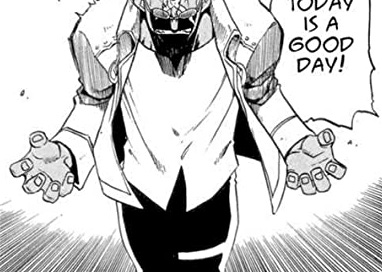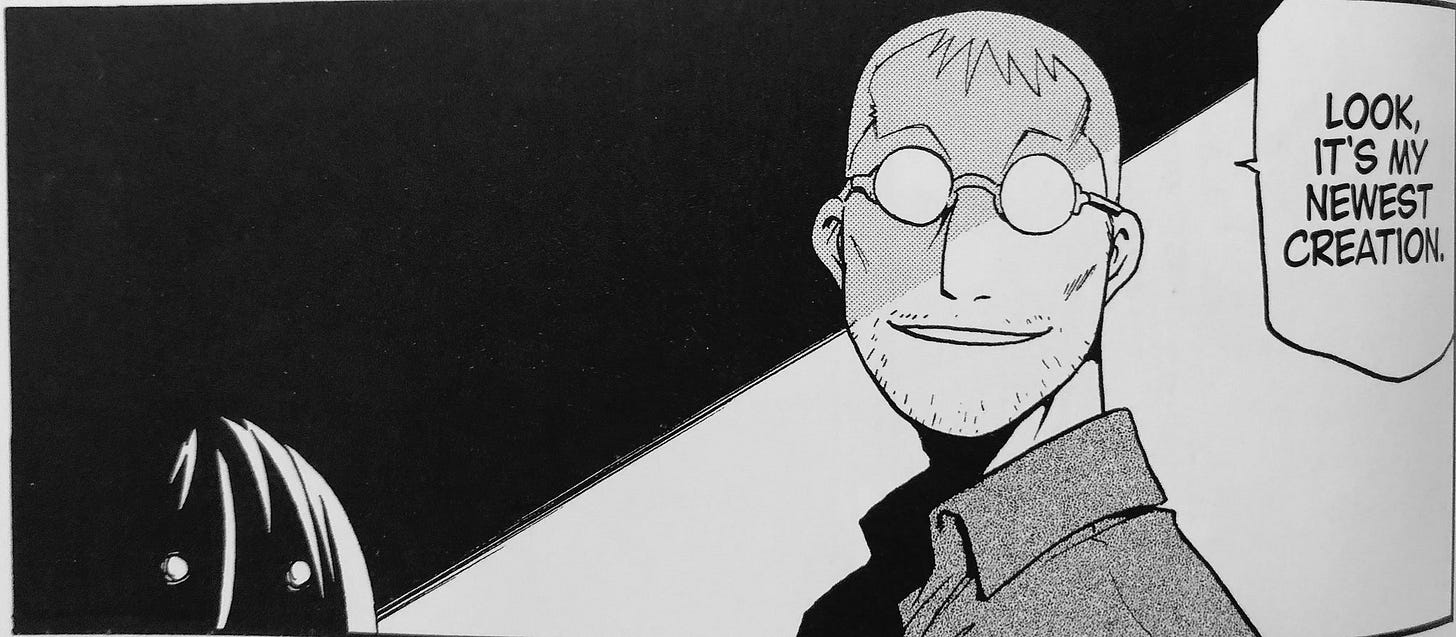Preface!
You’ve probably gathered by now, if you’ve read anything else here, that I dig villains. Mainly villains like Mahito, Dabi, Stain, who have a reason to be who they are, and make you ask important questions about what you thought you knew about their story.
Full Metal Alchemist has all those villains. Each and every one. The Homunculus, the Alchemists, and, of course, Scar. Versatile villains that, if the series played out from a different perspective, would see them not as villains at all, but as heroes in their own story.
Preface over. Full Metal Alchemist spoilers ahead!
Apparently I did Full Metal Alchemist wrong. I watched the original series, all five seasons, went through all the feels, and then was told that no, I was supposed to watch Brotherhood. Perhaps I was even shamed for it, we don’t need to get into that.
So I watched Brotherhood too, and went through all the feels again. After all of that, I read it too, because apparently I’m a masochist who loves suffering through Hughes’ death three times.
All that said, Full Metal Alchemist was one of my first forays into this medium and it left a lasting impact. Armstrong is forever ingrained in my head, flexing gracefully. But the character that really lingered, in all the right ways, is Scar.
Scar is a textbook hero of a different motivation, which is a phrase I think I just invented, but someone smarter than me may have used it at some point, who knows, I don’t feel the urge to find out.
Anyway, there used to be a differentiation between characters being flat or round. Flat characters filled a role, they were one-dimensional. Round characters had layers, complexities, flaws. I have long since given up on flat characters. I blame manga. Because just about every “flat” manga character rounds out throughout the course of the story and it’s not that hard to accomplish. Example: Nagi, from Blue Lock. Once singularly bored and uninspired (flat), he becomes so much more as he grows, gaining motivation, perspective and more (round).
I expect the same in other mediums now too.
Get on with it!
Okay, fine. Heroes of a different motivation are what make stories go further than just the point A to point B plot. They are the reminders that the point A to point B that we’re seeing is not the only one in any given story universe. That every character has a point A to point B, and the best characters are the ones whose point A to point B doesn’t align with the lead character, or—even better!—when it intersects in a non-peaceful way.
Some mainstream examples: Boromir, from Lord of the Rings. Not a villain, by any means, but his objective butts heads with Frodo’s when he tries to take the ring from him. The lazy reader may boo and hiss poor Boromir for being evil, but you need to check that and see it from Boromir’s point of view. He’s fighting to defend the entire world from Mordor on a daily basis. His point B is to protect Gondor and, by extension, everyone else.
Another mainstream example: Snape, from Harry Potter. One of the best characters of all time, he is presented as a villain to our protagonist’s story before we gradually see that his point B was much more in-line with Harry’s than we thought.
One more, for good measure: Zuko, from Avatar the Last Airbender. His point B was essentially the exact opposite of Aang’s, but gradually, over time, his point B moves and aligns with Aang.
The big consideration with at least those second two examples is how their point A to point B shifts. Does their motivation change as we get to know them? For Snape, it does. He was in fact a Death Eater at one point and gradually, over time, he came good and his point B moved.
Same goes with Zuko. His point B moved big time.
Boromir’s likely would too, if he hadn’t become a Gondorian pin cushion and suffered an untimely demise.
But notice, in each of those examples, did the point B shift for Frodo, Harry, Aang? Nope. Not even a little bit. More on that in a second.
In manga, Death Note’s classic tete-a-tete between Light and L is exactly that—two heroes of a different motivation clashing. The entire series is that simple concept and it works magnificently. Their respective point A to point B is the story.
Then there is Scar, from Full Metal Alchemist. Scar is presented as a major villain of immense power, basically imploding the entire Alchemy squad (the good guys) one poor sod at a time. His point B is the elimination of all the State Alchemists responsible for destroying his homeland. Hard to see that ever working in line with Ed and Al, who are fighting for the exact opposite—the State Alchemists and their seat of power.
But that is when Full Metal Alchemist really starts to shine. Because while we are used to seeing villains with complex and often sympathetic motivations (Stain, from My Hero Academia for instance), Scar plays a deep and lasting role on the plot of Full Metal Alchemist. And what I find most admirable about him and his arc is the way that his interactions with Al reshape both Scar’s and Al’s point B. Both. Al’s resolute dedication to the State Alchemists is shaken in a big way when he learns more about Scar and his background.
Let’s talk about Stain, because he’s worth more than a parenthetical. Stain is actually quite similar. Doesn’t trust in the goodness of heroes, but isn’t a relentless and brutal villain with no filter like my guy Mahito. He believes in All Might, the main hero of the story, and would never go after him, but “untrue” heroes he’s out to get.
You may call Stain and Scar reluctant villains, but I’ll stick with heroes of a different motivation. Because they have been so marred by the traditional heroes of the story that their motivation has been affected by it. Scar’s previous life was destroyed, his brother killed, and all because of State Alchemists. So of course we can empathize with his position, even as he slaughters legions of “good guys.”
But again, therein lies another utility of Scar to the overall story—he forces readers to rethink what they thought they knew about good guys and bad guys. Stain doesn’t do that. Well, maybe a tiny bit, but not really. Because Midoriya doesn’t come away from his battle with Stain rethinking his whole life and motivation. His point B doesn’t change at all.
Contrarily, Al’s does. He begins to see the cracks in the State Alchemist armor, which leads to much bigger things down the road.
Best of all, Scar is set up to be the hero of his own story from the off. Even in his early moments, when he’s framed as a villain, his moments of goodness seep in. He grants last requests, he has a kindness to him.
The lengths that the story goes to build Scar into a deep and complex character isn’t just in service to his individual character, but, as mentioned earlier, to the story as a whole. As readers, we need to start seeing the flaws in state alchemy and their military leadership. We need to start asking those questions so that, when the bigger revelations come, they feel justified. Like breadcrumbs for us to follow.
One last thing before I wrap this up—Shou Tucker! Gross, vile, hated, commits perhaps the most unspeakable act in his own madness. But he saw himself as a hero! And as readers, while we will always cringe (and maybe cry) because of what he did (literally spliced his dog and his daughter together), he didn’t do it “evilly,” he did it for a multitude of reasons, none of which were nefarious. They were good intentions, you could say.
I hate to end anything on Shou Tucker, because I hate him, but here we are.
For creative writers: Pick a character (bonus points if it’s your antagonist) and write down their point A and point B. Where does it cross your protagonist’s A to B?
For fans of Full Metal Alchemist: Very basic question, but who is your favorite character, and why?







I love this!!! It helps to have all the different examples. ANOTHER BANGER!!!